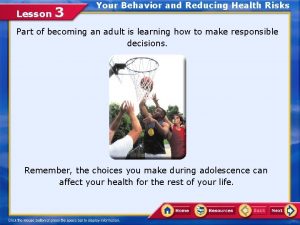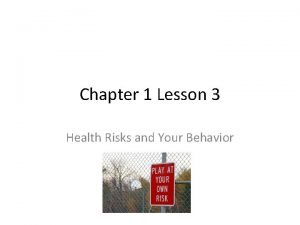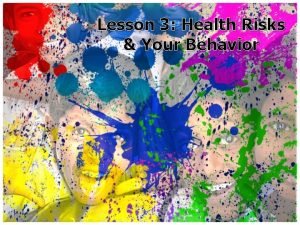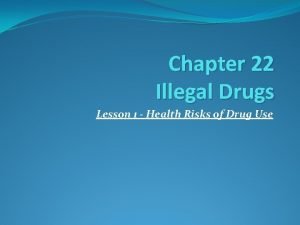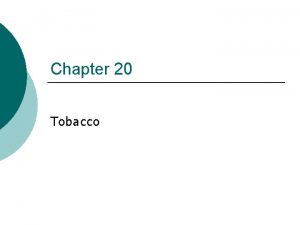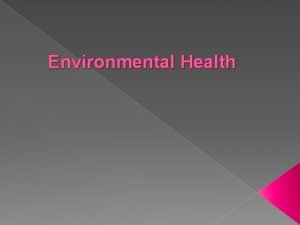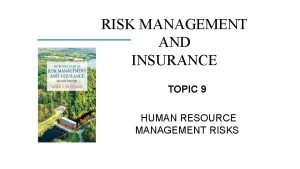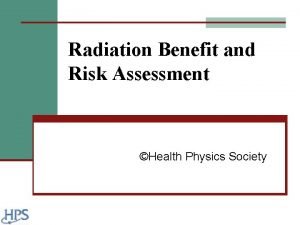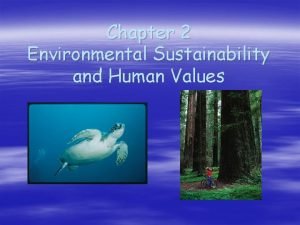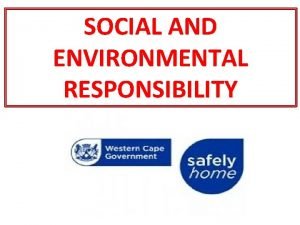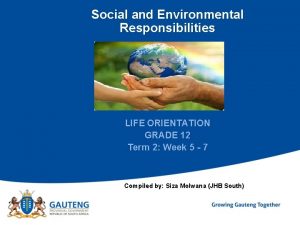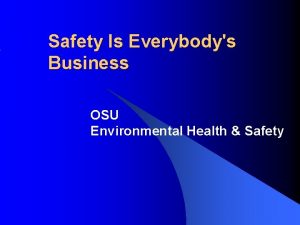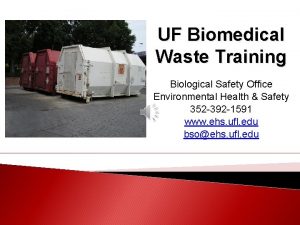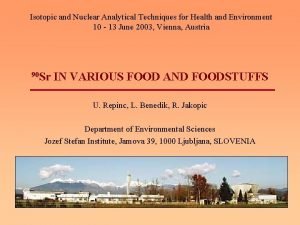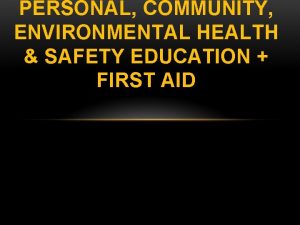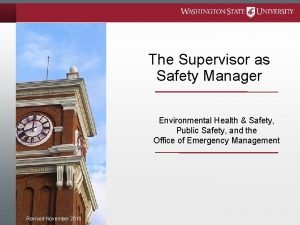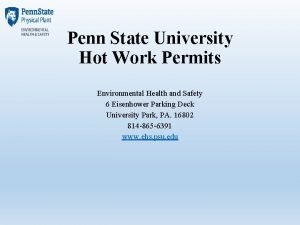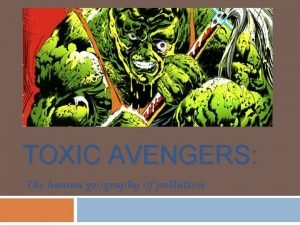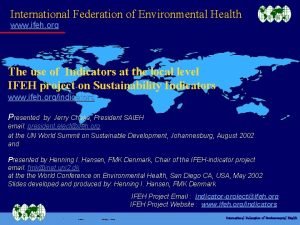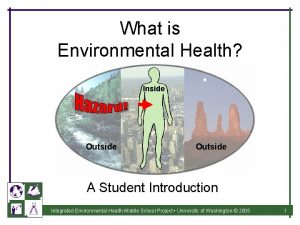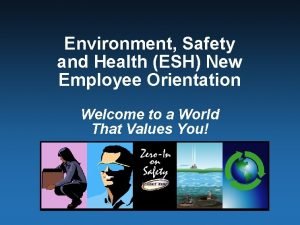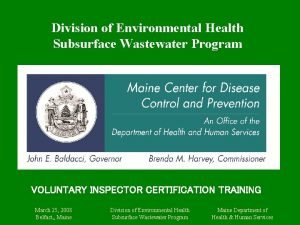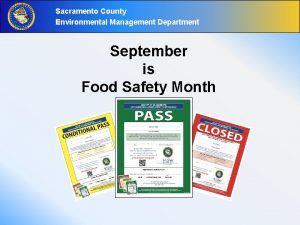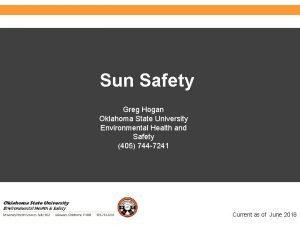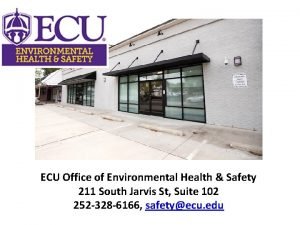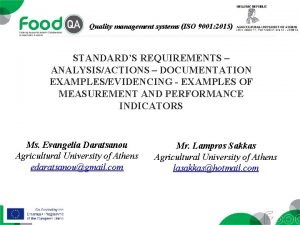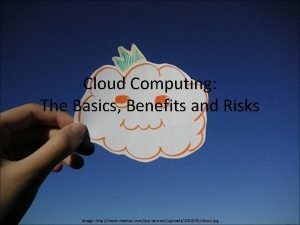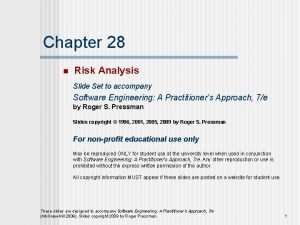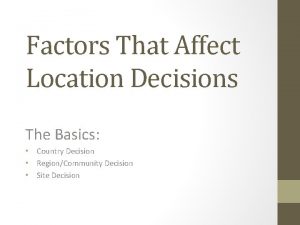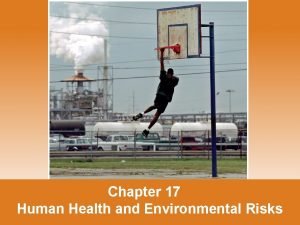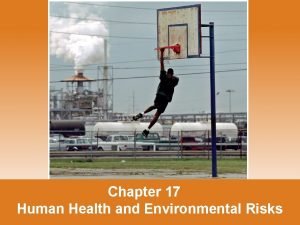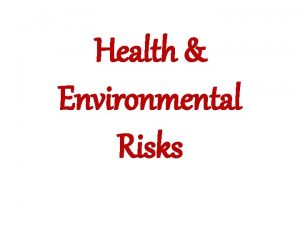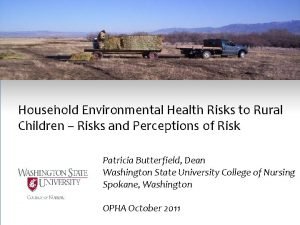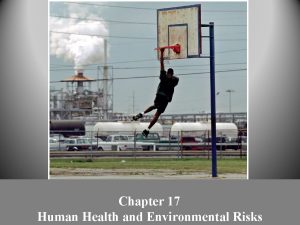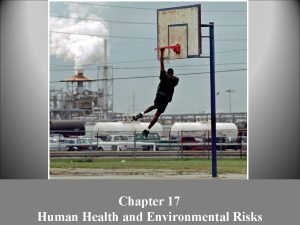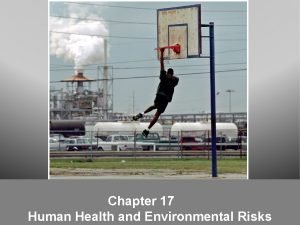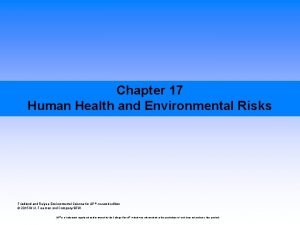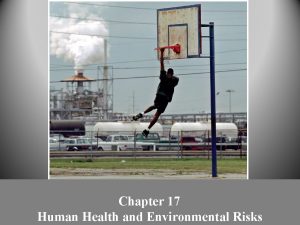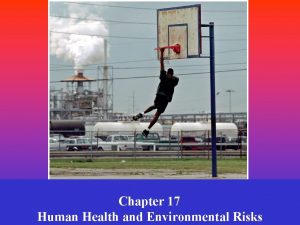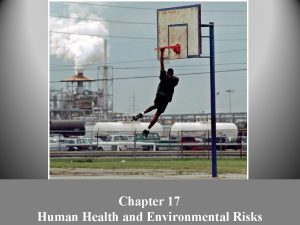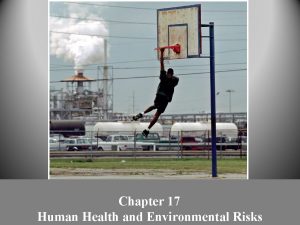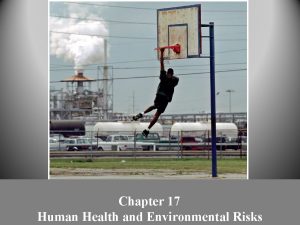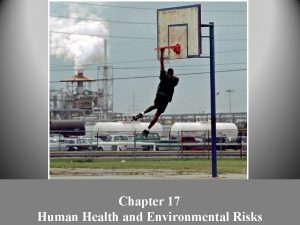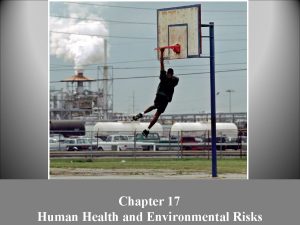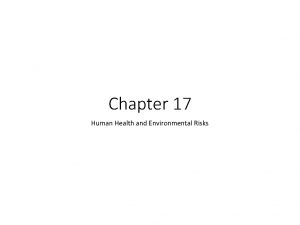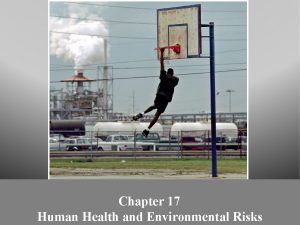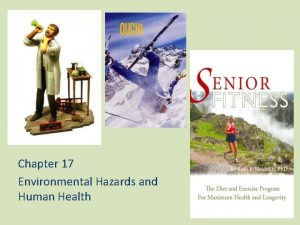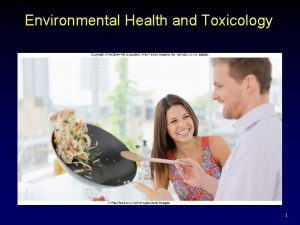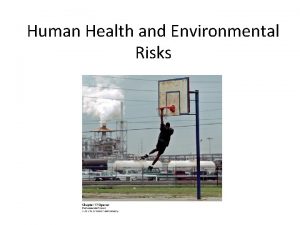Chapter 17 Human Health and Environmental Risks Risks



























































- Slides: 59

Chapter 17 Human Health and Environmental Risks


Risks and Hazards © Risk = a measure of the likelihood that you will suffer harm from a hazard © We can suffer from • • • Physical hazards: such as fire, earthquake, volcanic eruption… Biological hazards: from more than 1, 400 pathogens. Chemical hazards: in air, water, soil, and food, venom.

Biological Risks © Diseases not caused by living organisms cannot spread from one person to another (nontransmissible disease), while those caused by living organisms such as bacteria and viruses can spread from person to person (transmissible or infectious) © Infectious diseases- those caused by infectious agents, known as pathogens. © Examples: pneumonia and venereal diseases

Biological Risks © Chronic disease- slowly impairs the functioning of a person’s body. © Acute diseases- rapidly impair the functioning of a person’s body.

Disease is a major focus of environmental health • • Despite our technology, disease kills most of us Disease has a genetic and environmental basis • • Cancer, heart disease, respiratory disorders Poverty and poor hygiene foster illnesses

Infectious diseases kill millions • Infectious diseases kill 15 million people/year • • Half of all deaths in developing countries Money lets developed countries have access to hygiene and medicine

Infectious and noninfectious diseases • • Lifestyles in developed nations affect diseases • Smoking, obesity, etc Public health decreases some infectious diseases • • Some (AIDS) are spreading Some develop resistance to antibiotics


Diseases, the environment, and society • Our mobility spreads diseases - West Nile Virus spread from Africa to all lower 48 U. S. states in 5 years • New diseases are emerging - H 5 N 1 avian flu, H 1 N 1 swine flu • Climate change will expand the range of diseases • To predict and prevent

Killing large #s of People • Epidemic: when a pathogen causes rapid increase in disease (exceeds what is expected based on experience) • Pandemic: when an epidemic spreads through human populations across a large region, like a continent

Historical Diseases © Plague © Malaria © Tuberculosis

Emergent Diseases © HIV/AIDS-virus believed to have begun in chimps © Ebola-virus with many strains. Can be deadly © Mad Cow Disease-caused by cows being fed infected cow brain © Swine and Bird Flu-originated from bird © SARS (severe acute respiratory syndrome) © West Nile Virus-carried through mosquito


Chemical Risks © Neurotoxins- chemicals that disrupt the nervous system © Carcinogens- chemicals that cause cancer © Mutagens-causes damage to the genetic material © Teratogens- chemicals that interfere with the normal development of embryos or fetuses © Allergens- chemicals that cause allergic reactions, affecting the immune system © Endocrine disruptors- chemicals that interfere with the normal functioning of hormones in an animal’s body

Indoor environmental health hazards • Radon = a highly toxic, radioactive gas that is colorless and undetectable • • It can build up in basements Asbestos = a mineral that insulates, muffles sounds, and resists fire • Asbestosis = scarred lungs that cease to function

• Lead poisoning = caused by lead, a heavy metal Damages the brain, liver, kidney, and stomach Causes learning problems, behavior abnormalities, and death Education led to declines Exposure is from drinking in poisoning, but water China that flows through lead pipes orit from lead paint still used in toy paint • • • until recently

A recently recognized hazard • Polybrominated diphenyl ethers (PBDEs) = has fireretardant properties Used in computers, televisions, plastics, and furniture Persist and accumulate in living tissue Mimic hormones and affect thyroid hormones Also affect brain and nervous system development and may cause cancer Concentrations are rising in breast milk Now banned in Europe, concentrations have decreased The U. S. has not addressed the issue • •

• • Toxicology studies poisonous substances Toxicology = the study of the effects of poisonous substances on humans and other organisms Toxicity = the degree of harm a toxicant can inflict Toxicant = any toxic substance (poison) “The dose makes the poison” = toxicity depends on the combined effect of the chemical and its quantity Environmental toxicology = deals with toxic substances that come from or are discharged into the environment Studies health effects on humans, other animals, and ecosystems • •

• • Balancing risks and rewards There is a tradeoff between the risk and reward of most hazards • • • We must judge how these compare We use bisphenol (BPA) despite its health risks Are safer and affordable alternatives available? Don’t forget, chemicals have given us our high standard of living • Food, medicine, conveniences

• • • Toxic substances in the environment The environment contains natural chemicals that may pose health risks Toxins = toxic chemicals made in tissues of living organisms But synthetic chemicals are also in our environment • Every human carries traces of industrial chemicals The U. S. makes or imports 250 lb of chemicals for every person in the country

• Chemicals are in the air, water, and soil 80% of U. S. streams contain 82 contaminants • • Antibiotics, detergents, drugs, Pesticides are present in steroids, solvents, etc. streams and groundwater in levels high enough to affect aquifers contain 42 aquatic life 92% of all volatile organic compounds (from gasoline, paints, plastics, etc. ) • Less than 2% violate federal health standards for drinking water

Synthetic chemicals are in all of us • Every one of us carries traces of hundreds of industrial chemicals in our bodies • • • Including toxic persistent organic pollutants restricted by international treaties Babies are born “pre-polluted” – 232 chemicals were in umbilical cords of babies tested Not all synthetic chemicals pose health risks • But very few of the 100, 000 chemicals on the market have been tested

Dose-response analysis • Dose-response analysis = measures the effect a toxicant produces or the number of animals affected - At different doses • • • Dose = amount of substance the test animal receives Response = the type or magnitude of negative effects Dose-response curve = the dose plotted against the response

Dose-Response Studies © LD 50 - lethal dose that kills 50% of the individuals © ED 50 - effective dose that causes 50% of the animals to display the harmful but nonlethal effect

• The type of exposure affects the response Acute exposure = high exposure to a hazard for short periods of time Easy to recognize Stem from discrete events: ingestion, oil spills, nuclear accident, etc. Chronic exposure = low exposure for long periods of time More common but harder to detect and diagnose Affects organs gradually: lung cancer, liver damage Cause and effect may not be easily apparent • • •

Dose Response Studies • • • Dose-response studies: expose animals or plants to different amounts of a chemical and observe a variety of responses Acute studies: short duration experiments Chronic studies: longer duration of experiments, goal is to examine long-term effects of chemicals including effects on survival and impact

LD 50 Studies • To determine the dose of a chemical that causes a 50% death rate, scientists expose animals to different doses to determine what proportion will die at each dose

Number of individuals affected Very sensitive Majority of population Dose (hypothetical units) Very insensitive Fig. 18 -10, p. 430

Retrospective vs Prospective • • Retrospective study: a study on people who have been exposed to chemicals sometime in their past Prospective study: a study on people might be exposed to harmful chemicals in the future Ø Participants may be asked to track tobacco, food or alcohol intake to track future health problems

Human studies • • Case history approach = studies individual patients Autopsies tell us about lethal doses Don’t tell about rare, new, or low-concentration toxins Don’t tell about probability and risk Epidemiological studies = large-scale comparisons between exposed and unexposed groups Studies can last for years Yield accurate predictions about risk Measure an association between a health hazard an effect – but not necessarily the cause of the effect • • •

• Mixes may be more than the sum of their parts We can’t determine the impact of mixed hazards • • • They may act in ways that cannot be predicted from the effects of each in isolation Mixed toxicants can sum, cancel out, or multiply each other’s effects Synergistic effects = interactive impacts that are greater than the sum of their constituent effects • • New impacts may arise from mixing toxicants DDE may cause or inhibit sex reversal, depending on the presence of other chemicals (DDE results from breakdown of DDT)

Routes of Exposure

• Some toxicants persist Toxins can degrade quickly and become harmless • • • Or they may remain unaltered and persist for decades Rates of degradation depend on the substance, temperature, moisture, and sun exposure Breakdown products = simpler products that toxicants degrade into • • May be more or less harmful than the original substance DDT degrades into DDE, which is also highly persistent and toxic

Bioaccumulation bioaccumulation- an increased concentration of a chemical within an organism over time. Occurs when an organism absorbs the toxic substance at a greater rate than the substance is lost or broken down. © Properties of substances that bioaccumulate © Long lived © Mobile © Typically fat soluble ©

Bioaccumulation © The longer the half life of the substance leads to greater risk of chronic poisoning, even if levels of the toxin are not very high © A classic example: DDT (dichlorodiphyny-trichloroethane. It has a half-life of 15 years. © Can lead to biomagnification

Silent Spring began the debate over chemicals In the 1960 s, untested pesticides were sprayed over public areas, with assumption they would do no harm • • • Rachel Carson’s Silent Spring (1962) showed DDT’s risks to people, wildlife, and ecosystems Chemical companies challenged the book • Discrediting Carson’s personal reputation DDT was banned in the U. S. in 1973 • But is still made in the U. S. and exported

§DDT has rather low toxicity to humans §But §high toxicity to insects §If accidentally swallowed in large amounts, it can cause a person to become excitable, have tremors and seizures §In animals, harmful effects in reproduction and in the nervous system §Causes shell-thinning in birds, in particular carnivorous birds (raptors) such as ospreys and bald eagles

Biomagnification © Biomagnification- the increase in a chemical concentration in animal tissues as the chemical moves up the food chain.

Biomagnification • Biomagnification causes accumulation of toxins in the food chain. • • • Predators eat contaminated prey Pollutions accumulates at each stage of the food chain Top consumers, including humans, are most affected

Biomagnification of Other Pollutants Substance PCB’s Heavy Metals • Mercury, Copper, Cadmium, Chromium, Lead, Nickel, Zinc, Tin Cyanide Use & Problems • insulators in transformers • Fire retardant • Impairs reproduction • Widespread in aquatic systems • Mercury from gold mining • Many from metal processing • May affect nervous system • May affect reproduction • Used in leaching of gold • Used in fishing • Toxic

Persistence © Persistence- how long a chemical remains in the environment

We express risk in terms of probability • Exposure to health threats doesn’t automatically produce an effect Rather, it causes some probability (likelihood) of harm A substance’s threat depends on its identity and strength Chance and frequency of an encounter An organism’s exposure and sensitivity to the threat Risk = the probability that some harmful outcome will result from a given action, event, or substance Probability = describes the likelihood of a certain outcome • • •

Everything we do involves of some risk Perceptions may not match reality • • We try to minimize risk • • But perception may not match reality Flying versus driving We feel more at risk when we do not control a situation We fear nuclear power and toxic waste But not smoking or overeating -

Risk Analysis • • Environmental Hazard- anything in our environment that can potentially cause harm. Environmental substances include substances such as pollutants or other chemical contaminants, draining swamps, logging forests, or volcanoes and earthquakes. Hazards that are voluntary include smoking, tobacco… Hazards that are involuntary include pollution


Qualitative Risk Assessment © Making a judgment of the relative risks of various decisions © Probability- the statistical likelihood of an event occurring and the probability of that event causing harm

• Quantitative Risk Assessment Risk assessment = the quantitative measurement of risk Compares risks involved in different activities or substances It identifies and outlines problems Risk assessment has several steps: The scientific study of toxicity Assessing an individual or population’s exposure to the substance (frequency, concentrations, length) Teams of scientific experts review hundreds of studies Regulators and the public benefit from informed summaries • •

Risky Business • Risk acceptance determines how much risk can be tolerated • Risk management balances potential harms against other factors

Risk management • • Risk management = decisions and strategies to minimize risk Federal agencies manage risk The U. S. has the Centers for Disease Control (CDC), the EPA, the Food and Drug Administration (FDA) Scientific assessments are considered with economic, social, and political needs and values Comparing costs and benefits is hard Benefits are economic and easy to calculate Health risks (costs) are hard-to-measure probabilities of a few people suffering and lots of people not • • •


Worldwide Standards of Risk • • • Currently about 80, 000 regulated chemicals in the world but they are not regulated the same way around the world Innocent-until-proven-guilty principle assumes a substance is harmless - Helps technological innovation and economic advancement - But it allows dangerous substances to be used Precautionary principle assumes a substance is harmful until it is shown to be harmless - Identifies troublesome toxicants before being released - May impede the pace of technology and economic advance

Who should have to prove a product is safe: the manufacturers or government/citizens?

Assessing Chemical Hazards • • • Federal and state governments do not regulate about 99. 5% of the commercially used chemicals in the U. S. Estimating a chemical’s toxicity is difficult, uncertain, and expensive. Manufacturers contend that wide-spread application of the precautionary principle would make it too expensive to introduce new chemicals and technologies.

• • Philosophy affects policy Different nations use different policies for regulating synthetic substances Europe incorporates the precautionary principle The U. S. uses the innocent-until-proven-guilty approach Federal agencies involved in tracking and regulating synthetic chemicals include: • • The FDA: monitors food, food additives, cosmetics, drugs, medical devices The EPA: regulates pesticides and chemicals not covered by other laws

EPA regulation is only partly effective • The Toxic Substances Control Act (1976) = the EPA monitors chemicals made in or imported into the U. S. The EPA can ban substances that pose excessive risk Many health advocates think the TSCA is too weak Of 83, 000 chemicals, only five have been restricted To push for more testing, toxicity must already be proven, but testing is minimal Only 10% of chemicals have been tested for toxicity Fewer than 1% are regulated Almost none have been tested for endocrine, nervous, or immune system damage • •

FIFRA (1974) • The Federal Insecticide, Fungicide, and Rodenticide Act Charges the EPA with “registering” new pesticides manufacturers want to market The EPA asks the manufacturer to provide information on safety assessments The EPA examines ingredients, use, etc. to determine risks to people, other organisms, water, or air It approves, denies, or sets limits on the chemical’s sale and use and approves language used on the label Hazardous chemicals are approved if economic benefits outweigh hazards • • •

Europe’s REACH program • • The EU’s REACH program (Registration, Evaluation, Authorization, and Restriction of Chemicals) shifts the burden of proof for safety to industry Helps industries research and develop safer products Chemicals will be approved, deemed unsafe, or tested further 1, 500 chemicals will be replaced with safer ones REACH will cost industry $3. 8– 7 billion over 11 years Health benefits will be $67 billion over 30 years • •

Stockholm Convention on Persistent Organic Pollutants (POPs) © In 2001, a group of 127 nations gathered in Stockholm, Sweden, to reach an agreement on restricting the global use of some chemicals © 12 most dangerous POPs (known as the “dirty dozen”)were to be banned, phased out, or reduced. In 2013, 11 more were added to the list © These include DDT, PCBs, and certain chemicals that are by-products of manufacturing processes.
 Chapter 1 lesson 3 health risks and your behavior
Chapter 1 lesson 3 health risks and your behavior Related risks that increase in effect with each added risk
Related risks that increase in effect with each added risk Chapter 1 lesson 3 health risks and your behavior
Chapter 1 lesson 3 health risks and your behavior Chapter 22 lesson 1 health
Chapter 22 lesson 1 health A thick, sticky, dark fluid produced when tobacco burns.
A thick, sticky, dark fluid produced when tobacco burns. Chapter 20 lesson 1 the health risks of tobacco use
Chapter 20 lesson 1 the health risks of tobacco use Environmental health problems examples
Environmental health problems examples Marius meyer missing
Marius meyer missing Health risks
Health risks Lifewave antenna
Lifewave antenna Mh 605
Mh 605 Human needs and human development
Human needs and human development Chapter 8 human needs and human development
Chapter 8 human needs and human development The human body in health and disease chapter 2 answer key
The human body in health and disease chapter 2 answer key The human body in health and disease chapter 2 answer key
The human body in health and disease chapter 2 answer key Chapter 2 the human body in health and disease
Chapter 2 the human body in health and disease Chapter 3 health wellness and health disparities
Chapter 3 health wellness and health disparities Glencoe health chapter 1 understanding health and wellness
Glencoe health chapter 1 understanding health and wellness Chapter 1 health and wellness fundamentals
Chapter 1 health and wellness fundamentals Human values and sustainability
Human values and sustainability Society for human and environmental development
Society for human and environmental development Health social and environmental responsibility
Health social and environmental responsibility Social and environmental responsibility grade 10
Social and environmental responsibility grade 10 Osu environmental health and safety
Osu environmental health and safety Uf bloodborne pathogen training
Uf bloodborne pathogen training Health and environmental sciences institute
Health and environmental sciences institute Ehs oregon state
Ehs oregon state Personal community and environmental health
Personal community and environmental health Wsu environmental health and safety
Wsu environmental health and safety Ehs psu
Ehs psu Economic opportunities in media and information
Economic opportunities in media and information Hhd study design
Hhd study design Environmental injustice ap human geography
Environmental injustice ap human geography Centralized pattern definition ap human geography
Centralized pattern definition ap human geography Migrant diffusion
Migrant diffusion Urban sustainability ap human geography definition
Urban sustainability ap human geography definition Health and social component 3
Health and social component 3 International federation of environmental health
International federation of environmental health Precautionary principle
Precautionary principle Environmental health
Environmental health Esh environmental safety health
Esh environmental safety health Environmental health
Environmental health San diego department of environmental health
San diego department of environmental health Caribbean environmental health institute
Caribbean environmental health institute Sacramento county environmental health
Sacramento county environmental health 2 finger sunscreen rule
2 finger sunscreen rule Ecu environmental health
Ecu environmental health Actions to address risks and opportunities
Actions to address risks and opportunities Costs and risks of database approach
Costs and risks of database approach Cloud computing benefits and risks
Cloud computing benefits and risks Technology and operational risk
Technology and operational risk Workplace hazards and risks
Workplace hazards and risks Risks and mitigation slide
Risks and mitigation slide Understanding hazards and risks
Understanding hazards and risks Project finance risks and mitigants
Project finance risks and mitigants Lan domain risks threats and vulnerabilities
Lan domain risks threats and vulnerabilities What factors affect region/community location decisions
What factors affect region/community location decisions Human nouns
Human nouns Environmental science chapter 2
Environmental science chapter 2 Milwaukee county health and human services
Milwaukee county health and human services
